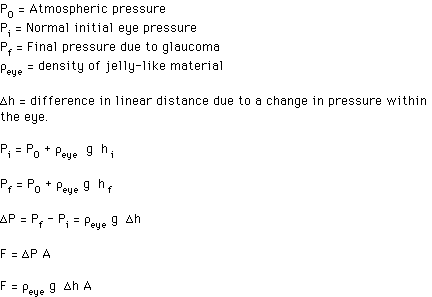 6) Substitude the given quantities
6) Substitude the given quantities
(Please follow steps 1-8 ) 1) problem title: The Eye Pressure: ( Glaucoma ) 2) Brife conceptual statements: Normally, liquide circulates constantly through the pupil, between iris and cornia, and is drained through a channel into veins. In glaucoma, the entrance to the drainage channel is blocked and the liquide builds up. As a result the pressure builds up in the eye. part of this extra pressure is exerted, via the lense, into the jelly-like fluid that fills the eyeball behined the lens. The jelly-like fluide in turns exert pressure on retina which causes the collapse of a tiny blood vessels that norish the eye-sensetive cells of retina and fibers of the optic nerve, both of which play a vital part in vision. Since they are deprived of the blood that provide them with essential nutrient and oxygen, the cells and nerve fibers begin to die, and vision begins to fade. 3) problem statement: The shape of the eye is maintained by fluid pressure, which is normally in the range of 12 to 24 mm Hg. When circulation of fluide in the eye is blocked, the pressure can become as great as 85 mm Hg. (one atmosphere=760mm Hg). How much force is exerted on the optic nerves? 4) What is given? a) Area in the back of the eye = 6 cm^2 = 6 x 10^(-4) m^2 b) linear difference in depth, due to the pressure within the eye = 85 x 10^(-3) m c) Density of the jelly-like fluid = 13.6 x 10^3 kg/m^3 d) Acceleration due to gravity = g = 9.8 m/s^2 5) Formulas:6) Substitude the given quantities
Answer: F = 6.8 N ~ 1.5 lbs (unrealestic answer)
7) Conclusions: Can you imagine an object weighting 1.5 lbs rests on your eye? It is recommended that people over 40 should routinely have their eyes checked for glaucoma. 8) Websites relavent to this problem.